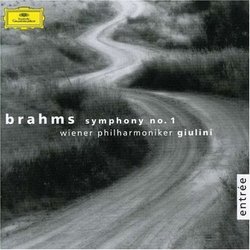| All Artists: Johannes Brahms, Carlo Maria Giulini, Vienna Philharmonic Orchestra Title: Brahms: Symphony No. 1 Members Wishing: 0 Total Copies: 0 Label: Dg Imports Original Release Date: 1/1/2003 Re-Release Date: 10/10/2003 Album Type: Import Genre: Classical Style: Symphonies Number of Discs: 1 SwapaCD Credits: 1 UPC: 028947416623 |
Search - Johannes Brahms, Carlo Maria Giulini, Vienna Philharmonic Orchestra :: Brahms: Symphony No. 1
 | Johannes Brahms, Carlo Maria Giulini, Vienna Philharmonic Orchestra Brahms: Symphony No. 1 Genre: Classical
|
Larger Image |
CD DetailsSimilar CDs
|
CD ReviewsA different view of Brahms's 1st Symphony Mr Darcy | australia | 08/31/2004 (5 out of 5 stars) "When this recording of Brahms's 1st Symphony was reissued in DG's entree series, I was somewhat taken aback. As the name of the series suggests, it is being promoted by DG as an ideal entry point to the classical repertoire for those hitherto unacquainted. One would therefore expect DG to include relatively solid mainstream performances that are likely to appeal to a broad cross section of listeners. This is anything but a mainstream performance. Indeed, it is one of the most individual performances of the Symphony that I have ever heard. I often wonder about the people who make decisions in major record companies these days. I can certainly think of more appropriate performances to include in this series, given the market DG is seeking to capture, and I can think of much better ways to promote this particular performance. But, there you are. I should not complain too much. DG has reissued a great performance which may appeal to those wanting a different view of the work. Moreover, it has been reissued at mid-price and with extra music. The first thing that will strike the listener in this performance is the richness, density and weight of the Vienna Philharmonic strings in the opening un poco sostenuto of the first movement. While praise should be extended to the DG engineers for capturing this, Giulini's contribution should not be ignored. Giulini was a violist in his early days, and this recording as well as others display his ability to extract a particular depth of tone from the strings, even in the best orchestras. The un poco sostenuto is delivered as if in one breath, taken neither particularly quickly nor slowly. It has a massive foreboding quality, which sets the keynote of this performance - one of ongoing struggle which is not really overcome until the final movement. The Vienna horns announce the following allegro with almost Mahlerian angst, and it is immediately clear that Giulini adopts a markedly slower tempo than most other conductors. It's obviously quicker than the preceding un poco sostenuto, but not significantly so. Initially, I found myself resisting this, but, as the movement progressed, I became convinced and utterly involved. That grinding tension, present in the un poco sostenuto, is carried through to the allegro. Even during those quieter moments of the movement, the tension is not relaxed. What Giulini seems to be doing here is emphasising the organic relationship between the un poco sostenuto and the following allegro. In other performances, these two parts are often taken at markedly different tempos (often very slow for the former and quite quick for the latter). Gunter Wand is another conductor who takes a similar approach in stressing the unity between the un poco sostenuto and the allegro. Giulini is in his element in the second movement's broad lyricism, moulding phrases with all the care that one would expect. There is repose, but the tragedy that infuses the first movement continues to extend a shadow over proceedings which is not really alleviated until the closing pages of the movement. In the third movement, the mood is more melancholic than usual. The opening pages of the final movement of this symphony constitute one of the most glorious orchestral passages ever written. Whenever I hear this music, my mind automatically thinks of rugged, mountainous landscapes, uninhabited and terrifying, and swathed in darkness until the thunderclap that precedes the noble theme played by the horns. This is a truly magical moment, when a ray of light appears to signal some hope. In my view, Giulini and the Viennese players evoke the atmosphere of these opening pages better than anyone. The horns are magnificent: intonation is spot on and their tone is refulgent. The accompanying strings meanwhile create a sense of almost unearthly mistiness, enhancing the sense of mystery. In the ensuing allegro, which opens with that famous noble melody, Giulini once again adopts speeds considerably broader than his counterparts, if not as controversially slow as in the first movement. But such is the expressiveness of the string playing and Giulini's strong accenting of rhythms that any sense of dragging is avoided. Noticeable again is Giulini's emphasis on contunity - after the initial statement of the famous melody, Giulini proceeds to the development without rush. Giulini tightens the screws in the coda to build a powerful and affirmative close, one which speaks of the resolve of the human spirit against significant odds rather than blazing triumph. This brings to an end a remarkably different but wholly coherent view of the work." The Slowest Greatest Roger W. Wood | Jacksonville, Florida | 06/20/2007 (5 out of 5 stars) "Leonard Bernstein once introduced a NYPO Beethoven 4th Piano Concerto concert by Glenn Gould with his own verbal introduction. Such was the controversy Gould initiated by insistence on his extraordinary "slow" playing of the 4th. Well, here is the Giulini equivalent. Certainly it is much slower than anything most of us are used to. But, if one listens to the whole thing, a miracle happens! It's darn good. In fact, it's original and brilliant and daring. On first hearing it, it touched me so deeply I was in tears. The VPO joins with CMG's artistic vision, and together they create an unique performance of the Brahms 1st Symphony. The conception is daring and brilliant and, yes, could be very personal. However, its brilliance provokes a controvery not unlike Bernstein's Moscow introduction (1959?)of the Shostakovitch 5th Symphony, almost double timing the fourth movement over traditional Russian performances. Brahms 1st Symphony is in good hands with Giulini. He is not only in my opinion the greatest Brahms conductor of the last half of the 20th century, but he has done the 1st over and over again the more traditional way in other recorded performances with the Philharmonia (2 that I know of), the LAPO, and the Bavarian Radio Symphony Orchestra. Who knows how many he's done? I understand he conducted the 1st in his last concert with a UN youth orchestra in Spain. The man conducted Brahms over 50 years. Now isn't he entitled to a more personal view of this Symphony? If one hears all the other performances of the 1st that he has done, it's quickly apparent that no one does it -- or has done it -- consistently better. Now if one listens to this performance all the way through, it will be a revelation and easily relegated to the more imporant performances available of the Brahms 1st. For Brahms listeners it is provocative, daring, and brilliant. Different, yes! But thoroughly Brahms, and rewarding listening. Don't let this one elude you if you covet Brahms and the brilliant Giulini Brahms performances as I do." Giulini, VPO, Brahms Sym 1: Slow, Intense, Inflected, Rich, Dan Fee | Berkeley, CA USA | 03/02/2009 (5 out of 5 stars) "Italian conductor Carlo Maria Giulini is fading from the media spotlights which, according to pop icon artist Any Warhol, will offer all of us our due, fifteen minutes of fame (followed by utter pop culture forgetfulness, it frequently seems). But Giulini has earned a sure place in the 20th century histories of our greatest conductors. He was a dissenter during the Mussolini era, and spent an intense youth in hiding, so he spent most of his hiding days studying his music scores.
After the war, Giulini quickly rose to musical attention. He had been a violist in the Augusteo Orchestra, and was invited to conduct the band. They broadcast a radio performance of a Haydn oratorio which just happened to be heard by none other than Arturo Toscanini. Then Giulini was taken under Toscanini's mentoring wings, to good effect. After the disruptions and deaths of WWII, people in all countries were more or less hungry for music - and available talent was sought and prized. As the European musical scene began to revive, Giulini found his way to England, where he gained the favor - quite a good chance - of EMI head executive Walter Legge. Legge had hand-picked the Philharmonia players, putting Otto Klemperer at the helm, and then Legge lured both the young von Karajan and Giulini to back up Klemperer. What glory days, indeed. My first set of the complete Brahms symphonies was, in fact, the Philharmonia recordings led by Giulini, published on EMI. I heard many other readings over the years. The Giulini EMI set endured until it started to disappear from the commercial catalogs, just about the time the industry finally switched totally from stereo and vinyl, to red book CD. Eventually, Giulini had a significant tenure with the Chicago Symphony, much of which was captured by EMI and DGG. That meant, a second Brahms fourth symphony, with Chicago. Then a west coast surprise happened, when Giulini was invited to become music director of Los Angeles. The surprise is not so much that he was invited - his preeminence was pretty much unquestioned by that time; but that he accepted. So we got additional readings of the Brahms first and second symphonies with the LA Philharmonic, published on DGG. Still. Dyed in the wool fans were left hanging. No label had managed a second repeat set of the four Brahms symphonies, though the high excellence of the Chicago fourth and the LA first and second left us all more or less intensely wishing for one. Then finally, in what proved to be the late autumn of Giulini's remarkable career, DGG published a number of additional performances, many with the venerable Vienna Philharmonic. (Sony CBS also brought out some notable late recordings, usually with the Amsterdam Concertgebouw.) Now, we got a new set of the four Brahms. What readings. Alas, mine were kept by a school friend who borrowed them and never quite got around to giving them back. By the time I tried to replace them - they had gone out of print. Now, all four readings are back. The first is available in two editions. A DGG import is available via Amazon, plus Arkiv music dot com has gained the rights to release all four discs in their burn on demand catalog. In this second full set, the conductor has slowed from his set on EMI. But if anybody knew what to do with deliberate tempos, Carlo MG fits the bill. He is also warm, generous, and not at all afraid to have the great Vienna orchestra caress and inflect passing phrases. Indeed, at times, whole musical paragraphs. Think, Rafael Kubelik, perhaps - an old Decca set with Vienna, or an Orfeo set with the Bavarian Radio. Now, the late autumn season's approach to the composer is going to be controversial in some quarters. These views of the four symphonies are coming, after all, from a great conductor of the past century who spent decades leading these works with any number of the planet's great bands. Giulini deepened his music-making over the years, so what the second DGG Universal set gives us is his later grasp of Brahms, not his youthful one. No matter to me, though. If anybody leading an orchestra can persuade me as a listener, hearing this expansive, rich, high calorie view of Brahms, the winners would have to include Carlo Maria Giulini. It doesn't hurt that such an autumnal reading of complex inflection is played by the incomparable Vienna Philharmonic, responding beautifully to this leader. The readings offer completely committed, sincere music-making, old school. Every single note played on a very high level of musical narrative and drama. All the new kids on the new century's block have yet to offer us Brahms like this, with elegant golden age manners. I do love some of the newer readings, which tend to barrel down on us like a freight train, only to release HIP manners of the utmost winged lightness - as if Brahms were all about a most wonderous hang-gliding display. To get the old school glow with plenty of orchestra sizzle and detail, we only need return to Bruno Walter, Klemperer, Furtwaengler, Kurt Sanderling, or even George Szell in Cleveland. (Will the new globalized Sony BMG ever finish SACD remasters of the Walter, and give us the full Szell, too?) Updates that continue golden age manners can be heard from Dohnanyi in Cleveland, and Thomas Sanderling with the contemporary London Philharmonia. (I seem to recall that Dohnanyi is now recording his second set, on Signum, with that same Philharmonia where he has been music director for a while now.) Grab this first, and the other three symphonies that comprise Giulini's full second set. Who knows how long they will be available? All four readings are genuine finds, fit for musical treasure hunters of all ages, and all backgrounds. Surely you will end up, renewed, as a fan of Vienna, of Brahms, and of Carlo Maria Giulini. Whomever else one may add to the fav shelves, Giulini comes to stay, to be cherished. One caution? Do not loan Giulini out, as you may never get your disc back." |

 Track Listings (14) - Disc #1
Track Listings (14) - Disc #1![Zum Meer [Single-CD]](https://nationalbookswap.com/cd//m/02/3202/1323202.jpg)

